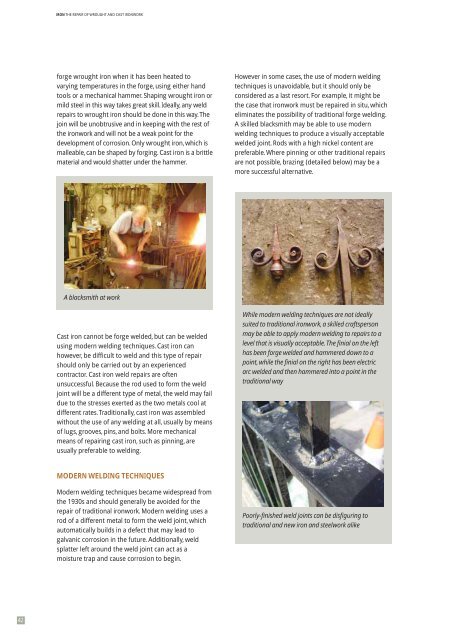The Repair of Wrought and Cast Iron Work - Dublin City Council
The Repair of Wrought and Cast Iron Work - Dublin City Council
The Repair of Wrought and Cast Iron Work - Dublin City Council
Create successful ePaper yourself
Turn your PDF publications into a flip-book with our unique Google optimized e-Paper software.
IRON THE REPAIR OF WROUGHT AND CAST IRONWORK<br />
forge wrought iron when it has been heated to<br />
varying temperatures in the forge, using either h<strong>and</strong><br />
tools or a mechanical hammer. Shaping wrought iron or<br />
mild steel in this way takes great skill. Ideally, any weld<br />
repairs to wrought iron should be done in this way. <strong>The</strong><br />
join will be unobtrusive <strong>and</strong> in keeping with the rest <strong>of</strong><br />
the ironwork <strong>and</strong> will not be a weak point for the<br />
development <strong>of</strong> corrosion. Only wrought iron, which is<br />
malleable, can be shaped by forging. <strong>Cast</strong> iron is a brittle<br />
material <strong>and</strong> would shatter under the hammer.<br />
However in some cases, the use <strong>of</strong> modern welding<br />
techniques is unavoidable, but it should only be<br />
considered as a last resort. For example, it might be<br />
the case that ironwork must be repaired in situ, which<br />
eliminates the possibility <strong>of</strong> traditional forge welding.<br />
A skilled blacksmith may be able to use modern<br />
welding techniques to produce a visually acceptable<br />
welded joint. Rods with a high nickel content are<br />
preferable. Where pinning or other traditional repairs<br />
are not possible, brazing (detailed below) may be a<br />
more successful alternative.<br />
A blacksmith at work<br />
<strong>Cast</strong> iron cannot be forge welded, but can be welded<br />
using modern welding techniques. <strong>Cast</strong> iron can<br />
however, be difficult to weld <strong>and</strong> this type <strong>of</strong> repair<br />
should only be carried out by an experienced<br />
contractor. <strong>Cast</strong> iron weld repairs are <strong>of</strong>ten<br />
unsuccessful. Because the rod used to form the weld<br />
joint will be a different type <strong>of</strong> metal, the weld may fail<br />
due to the stresses exerted as the two metals cool at<br />
different rates. Traditionally, cast iron was assembled<br />
without the use <strong>of</strong> any welding at all, usually by means<br />
<strong>of</strong> lugs, grooves, pins, <strong>and</strong> bolts. More mechanical<br />
means <strong>of</strong> repairing cast iron, such as pinning, are<br />
usually preferable to welding.<br />
While modern welding techniques are not ideally<br />
suited to traditional ironwork, a skilled craftsperson<br />
may be able to apply modern welding to repairs to a<br />
level that is visually acceptable. <strong>The</strong> finial on the left<br />
has been forge welded <strong>and</strong> hammered down to a<br />
point, while the finial on the right has been electric<br />
arc welded <strong>and</strong> then hammered into a point in the<br />
traditional way<br />
MODERN WELDING TECHNIQUES<br />
Modern welding techniques became widespread from<br />
the 1930s <strong>and</strong> should generally be avoided for the<br />
repair <strong>of</strong> traditional ironwork. Modern welding uses a<br />
rod <strong>of</strong> a different metal to form the weld joint, which<br />
automatically builds in a defect that may lead to<br />
galvanic corrosion in the future. Additionally, weld<br />
splatter left around the weld joint can act as a<br />
moisture trap <strong>and</strong> cause corrosion to begin.<br />
Poorly-finished weld joints can be disfiguring to<br />
traditional <strong>and</strong> new iron <strong>and</strong> steelwork alike<br />
42

















